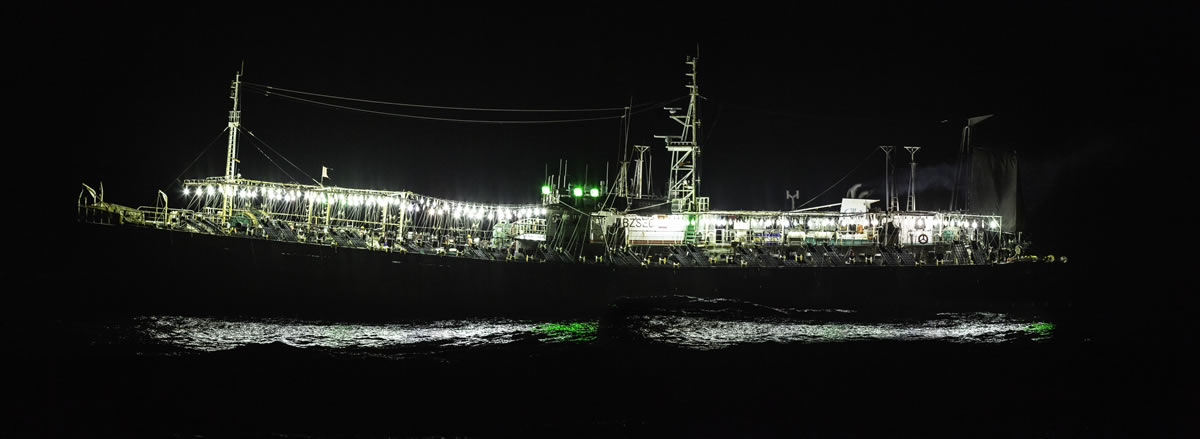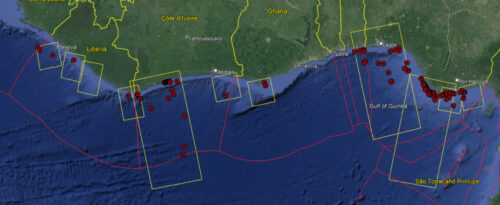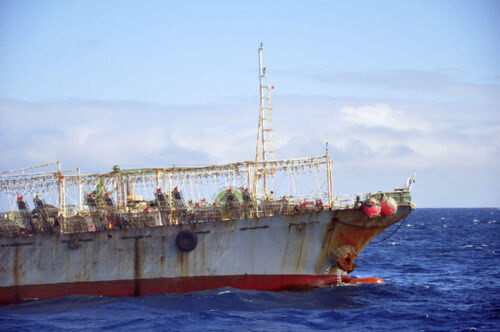An analysis of the 2020 squid season reveals key players and true scope of fishing activity
The jumbo flying squid (Dosidicus gigas), commonly referred to as Humboldt squid, is the most abundant cephalopod species in the southeast Pacific Ocean. Each year, this voracious and highly migratory marine animal attracts hundreds of fishing vessels from around the world to the waters off Latin America as fishers vie to take home catch.
Traveling along the coastlines of Ecuador, Peru and Chile the jumbo squid is of high socio-economic importance to communities throughout the region, not just as a source of food security but for income as well. In Peru, where squid represent the largest artisanal fishery, squid comprises 43 percent of their export product, equating to hundreds of thousands of tons annually.
Representing the second largest fishery managed by the South Pacific Regional Fisheries Management Organization (SPRFMO), the total annual catch of jumbo squid has dramatically increased each year. While this growth in catch has helped underpin local economies, the elusive nature of this creature means that little is known about the sustainability of the stock.

To build a more accurate picture of fishing activity taking place on our ocean and support scientific research on the health and spatial and temporal distributions of the stock, Global Fishing Watch undertook an analysis of the 2020 squid fishing season throughout the Southeast Pacific Ocean. Aiming to support monitoring, control and surveillance efforts and better understand the footprint of the fleet, or how and where vessels were operating, our team combined three types of technology—automatic identification system (AIS) data, synthetic aperture radar (SAR), and a nighttime optical imagery called visible infrared imaging radiometer suite (VIIRS)—and cross referenced the resulting datasets with SPRFMO records. The detailed analysis not only revealed the size and location of the fleets, but also their spatial patterns, fishing effort and behavioral trends. Here’s what you need to know.
1. Big means big. The squid fleet, spanning 615 vessels, spent a total of 876,366 hours fishing during 2020, equivalent to 94,559 days. The busiest time of the season—the point during which the maximum number of vessels were present—fell between January and March when a total of 467 fishing vessels were identified, mainly in the high seas around the western Galápagos and high seas off southern Peru.
2. Squid are migratory and always on the move. The analysis focused on a specific area of interest nearly 4.2 million square miles (10.8 million square kilometers) which runs along the Peruvian coast to waters about 1000 nautical miles west of the Ecuadorian Galápagos and in parallel with the equator. From January to March, squid fishing was concentrated in the western Galápagos high seas and on the border of Argentine waters. From there, vessels transited towards the high seas off Peru and Ecuador. The vessels in front of Argentina’s exclusive economic zone (EEZ) travel through Chilean waters on their way to the Pacific. The fleet concentrated its activity just south of the Galápagos EEZ and outside of the northern border of Peruvian waters. During the last quarter of the year, the fleet split, moving farther south along Peru’s EEZ border and west of the Galápagos.
3. One SPRFMO member is responsible for almost all the vessels operating in the region. While vessels operating in the area of interest were flagged to multiple SPRFMO members and authorized to fish in the region, a total of 95 percent of the 615 squid vessels identified in the analysis were flagged to China. The remaining 5 percent were flagged to Chinese Taipei and the Republic of Korea. A small number of carrier vessels were also present, the majority of which were flagged to Panama. Additionally, the total number of vessels identified with AIS was contrasted with the SPRFMO list of active vessels, being that 82 vessels were not listed as active in the convention area during 2020 but were actively identified with AIS tracking data. This finding highlights the potential risk of vessels being in operation to report their catches or transshipments to the flag State or SPRFMO as is required under Article 27 of the Convention.
4. Three types of “irregularities” were observed when analyzing the squid fleet.

Multiple MMSI numbers: Some vessels used multiple maritime mobile service identity (MMSI) numbers—identification numbers, which are assigned by the flag State and intended to be unique. Nineteen of the 615 vessels operating throughout the eastern and southeastern Pacific Ocean were using multiple AIS devices and collectively transmitting 41 different MMSI numbers, potentially contravening flag State rules around maritime radio licensing. Just under half of those 19 vessels were operating under different vessel names for each AIS unit onboard.

Shared MMSI numbers: A single MMSI number was also seen to be used more than once across 47 different squid vessels—all were flagged to China. The analysis shows that the most common cases of sharing an MMSI number occurred when one vessel was fishing in Latin American waters, while its partner MMSI vessel was located several thousand miles away within Chinese waters. Of these 47 vessels, the authorization status of three could not be confirmed, according to SPRFMO records.
False AIS positions: Also known as “spoofing,” vessel operators can broadcast an AIS position that is actually outside the reception footprint of the receiving satellite. In other words, they can make it look like the vessel they are operating in is not where it actually is. A total of 16 squid vessels, all flagged to China, were identified with AIS position outside their receiving satellite’s perimeter. These vessels had a constant offset of -41.7 degrees of latitude and -85.4 degrees of longitude. Global Fishing Watch developed a technique to correct a vessel’s location when offsetting occurs, repositioning it within the footprint of the receiving satellite. AIS offsetting is not always a result of unscrupulous behavior. It can also occur when data gets corrupted, making investigative follow up an important step in determining whether these false positions are part of a larger attempt to conceal vessel tracks.
5. Transparency is key to improved monitoring, control and surveillance of fishing and transshipment activity. In any analysis, it is alarming when numbers don’t add up. This is especially true when it comes to transshipment, or the transfer of catch between fishing vessels and refrigerated cargo vessels, otherwise known as carriers. Our AIS analysis shows a significantly greater number of active carriers—and far less transshipment events— than what was reported into SPRFMO implementation reports. Last year, China reported 2,930 transshipment events where one of its vessels transferred jumbo squid. That’s nearly 2,000 more than the 1,039 observed encounters identified on AIS. This is likely due to the fact that a significant percentage of transshipments were, in fact, being conducted during what were deemed as loitering events—when a single vessel exhibits behavior indicative of an encounter with another vessel—and when no AIS transmissions were received. What’s more curious is the alarmingly low number of carriers identified by SPRFMO’s active vessel list—a total of 12—when AIS identified 41. A similar discrepancy was also seen in one flag State’s records: SPRFMO’s active list identified 22 registered carriers, but the flag State only reported 15 (involved in 779 transshipments of jumbo squid), while the AIS data we gathered actually revealed 24 active carriers.
Sustainable management of squid fisheries depends on a culture of compliance—and compliance begins with transparency. This analysis highlights how transparency can be used as a cost-effective tool to support monitoring, control and surveillance (MCS) of the squid fishery in this region. To support these efforts, SPRFMO member States should investigate apparent manipulation of AIS information and cooperate with coastal States to provide detailed information on vessel activity that appears to occur along or within EEZs.
Chile, Ecuador, Panama and Peru have committed to share identification and tracking data for their vessels, leading the way in the adoption of transparency as a tool to drive greater ocean governance. In the spirit of transparency, we encourage all SPRFMO member States to publish vessel data for their fleets, demonstrating vessel compliance and support for enhanced management efforts.
By improving access to information, stakeholders will have better oversight of fishery data and practices. With this information, management and protection measures can be designed to account for both the economic security of the commercial fishing industry and the food security of the small-scale fishing sector
Edaysi Bucio Bustos is a fisheries analysis coordinator for Global Fishing Watch.
You might also like...


Advances in Satellite Radar Analysis Help Reveal Fishing Activity
